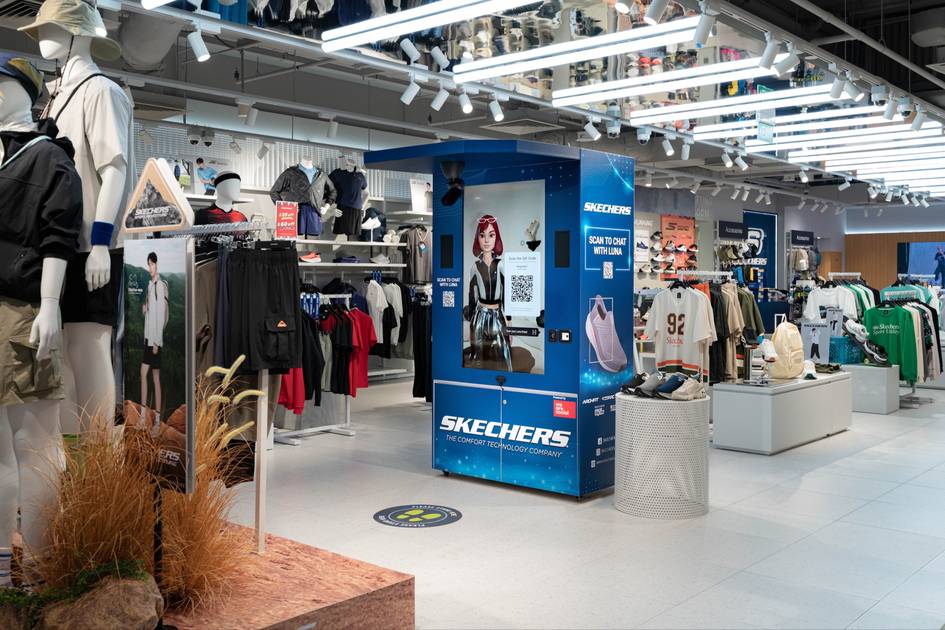Skechers’ AI shop assistant is friendly, chatty—and watching what you wear
Skechers, Singapore Credits: Courtesy Skechers The physical store is not dead, but it is being reprogrammed. Skechers, the U.S. footwear company known less for fashion cachet than for functional comfort, is attempting a digital leap forward with the launch of Luna—an AI-powered retail assistant installed at its new flagship in Singapore’s Punggol Coast Mall. Described as a “personal stylist,” Luna uses a mix of speech-to-speech artificial intelligence and messaging integration to advise customers on what to buy, based on what they are wearing or browsing. Shoppers can interact with Luna via an in-store kiosk or continue the conversation later on Telegram—one of the more telling aspects of the rollout, signalling a shift in how brands hope to blur the boundaries between physical and digital commerce. “As a comfort technology brand, harnessing new and innovative solutions to connect with our customers is part of our DNA,” said Irene Lee, senior general manager at Skechers Singapore. “With the opening of our new store in Punggol Digital District, it enhances customers' retail journey with a unique, social, and interactive experience with Luna.” Developed by We Are Social Singapore, the initiative is more than just a gimmick tied to a store opening. It marks a growing retail interest in deploying AI agents not only as customer service tools but as data-gathering intermediaries—interfaces that can learn from shoppers’ preferences in real time and potentially reshape inventory, merchandising, and marketing strategies accordingly. Indeed, Luna’s conversational interface is not simply reactive. It collects and processes data with each interaction, using it to generate style suggestions and product matches. Manolis Perrakis, innovation director at We Are Social Singapore, positioned the system as part of a broader trend: “The emergence of AI speech-to-speech technologies is powering an agentic AI revolution that forms the backbone of future consumer-facing systems.” This may be the real story. While the idea of a machine that suggests the right trainers to go with your jacket might appear convenient—or even charming—the underlying ambition is strategic. Retailers are no longer just selling shoes; they are building adaptive feedback loops with consumers. Luna’s goal is not simply to assist, but to integrate: across in-store, mobile, and e-commerce channels, creating what Perrakis calls a “seamless ecosystem.” The AI sales associate as data funnel This seamlessness has costs as well as benefits. For one, it elevates customer engagement at the potential expense of privacy. With AI-powered assistants learning in real time, brands may acquire more intimate behavioural insights than most shoppers realise—particularly if interactions shift to private messaging platforms like Telegram, where communication is perceived as more casual or secure. Moreover, the experience economy that underpins such activations still carries risk. AI agents like Luna may streamline decision-making, but they lack the serendipity and human improvisation that defines the best retail encounters. As retailers chase efficiency and personalisation, they may also need to guard against reducing fashion to a series of transactional micro-recommendations. There is also the question of scalability. While a sleek activation in a forward-thinking district like Punggol may create a buzz, integrating such systems across legacy retail infrastructure—often fragmented and not built with interoperability in mind—presents considerable challenges. The more sophisticated the AI, the more invisible and extensive the infrastructure required to support it. Still, the logic is clear. In a retail landscape increasingly defined by “phygital” convergence, AI offers the potential to turn every touchpoint into a moment of brand engagement—and data collection. Whether customers experience this as helpful or invasive may determine how widely such systems are embraced. For now, Skechers is betting that the novelty of a chatty machine stylist—plus the comfort of its footwear—will be enough to entice. But what’s certain is that with each new deployment, AI is not just entering the store. It is redefining what the store is for.

The physical store is not dead, but it is being reprogrammed. Skechers, the U.S. footwear company known less for fashion cachet than for functional comfort, is attempting a digital leap forward with the launch of Luna—an AI-powered retail assistant installed at its new flagship in Singapore’s Punggol Coast Mall.
Described as a “personal stylist,” Luna uses a mix of speech-to-speech artificial intelligence and messaging integration to advise customers on what to buy, based on what they are wearing or browsing. Shoppers can interact with Luna via an in-store kiosk or continue the conversation later on Telegram—one of the more telling aspects of the rollout, signalling a shift in how brands hope to blur the boundaries between physical and digital commerce.
“As a comfort technology brand, harnessing new and innovative solutions to connect with our customers is part of our DNA,” said Irene Lee, senior general manager at Skechers Singapore. “With the opening of our new store in Punggol Digital District, it enhances customers' retail journey with a unique, social, and interactive experience with Luna.”
Developed by We Are Social Singapore, the initiative is more than just a gimmick tied to a store opening. It marks a growing retail interest in deploying AI agents not only as customer service tools but as data-gathering intermediaries—interfaces that can learn from shoppers’ preferences in real time and potentially reshape inventory, merchandising, and marketing strategies accordingly.
Indeed, Luna’s conversational interface is not simply reactive. It collects and processes data with each interaction, using it to generate style suggestions and product matches. Manolis Perrakis, innovation director at We Are Social Singapore, positioned the system as part of a broader trend: “The emergence of AI speech-to-speech technologies is powering an agentic AI revolution that forms the backbone of future consumer-facing systems.”
This may be the real story. While the idea of a machine that suggests the right trainers to go with your jacket might appear convenient—or even charming—the underlying ambition is strategic. Retailers are no longer just selling shoes; they are building adaptive feedback loops with consumers. Luna’s goal is not simply to assist, but to integrate: across in-store, mobile, and e-commerce channels, creating what Perrakis calls a “seamless ecosystem.”
The AI sales associate as data funnel
This seamlessness has costs as well as benefits. For one, it elevates customer engagement at the potential expense of privacy. With AI-powered assistants learning in real time, brands may acquire more intimate behavioural insights than most shoppers realise—particularly if interactions shift to private messaging platforms like Telegram, where communication is perceived as more casual or secure.
Moreover, the experience economy that underpins such activations still carries risk. AI agents like Luna may streamline decision-making, but they lack the serendipity and human improvisation that defines the best retail encounters. As retailers chase efficiency and personalisation, they may also need to guard against reducing fashion to a series of transactional micro-recommendations.
There is also the question of scalability. While a sleek activation in a forward-thinking district like Punggol may create a buzz, integrating such systems across legacy retail infrastructure—often fragmented and not built with interoperability in mind—presents considerable challenges. The more sophisticated the AI, the more invisible and extensive the infrastructure required to support it.
Still, the logic is clear. In a retail landscape increasingly defined by “phygital” convergence, AI offers the potential to turn every touchpoint into a moment of brand engagement—and data collection. Whether customers experience this as helpful or invasive may determine how widely such systems are embraced.
For now, Skechers is betting that the novelty of a chatty machine stylist—plus the comfort of its footwear—will be enough to entice. But what’s certain is that with each new deployment, AI is not just entering the store. It is redefining what the store is for.




















































































































































